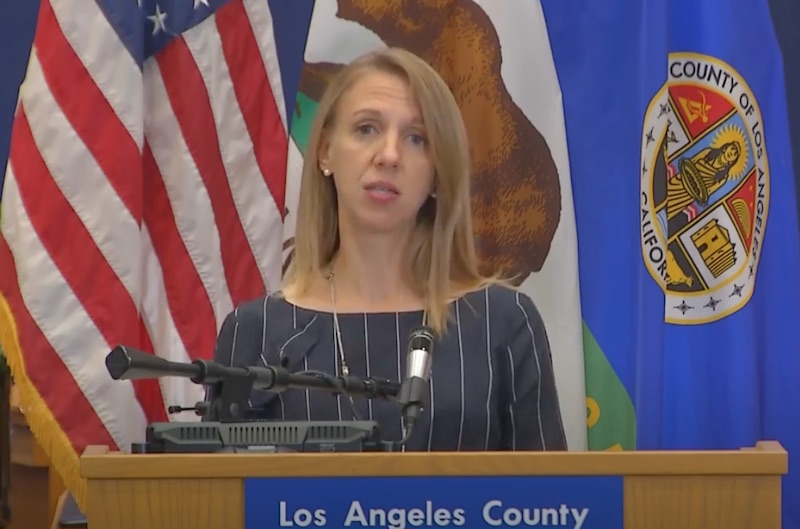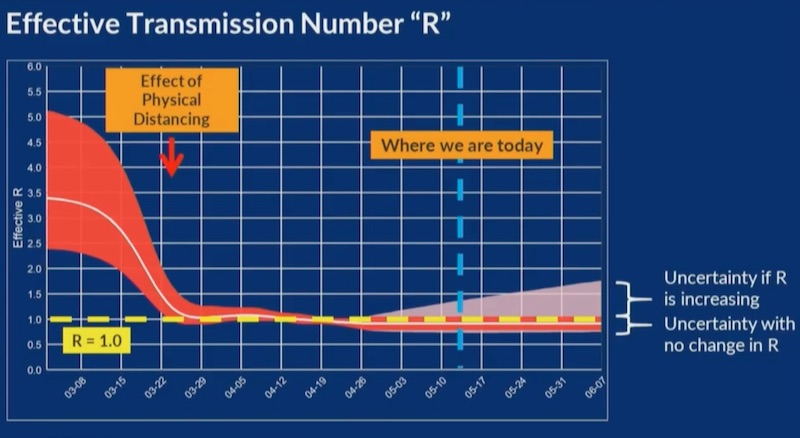
As Los Angeles County continues to reopen certain retail and recreation opportunities, you may be wondering how the Public Health Department decides whether to move forward or retreat. You might also wonder how much the Safer at Home order, physical distancing, hand washing, and cloth face coverings actually help. Department of Health Services director Christina Ghaly, M.D. broke that down in a county briefing this afternoon.
Ghaly presented the following model:

Here, “R” represents the “basic reproduction number,” or how many other people one person with COVID-19 would infect. In the beginning of the pandemic, R was just over 3. According to Ghaly, that’s a high rate of spread and considerably higher than seasonal influenza. The drop in March correlates with our Safer at Home order and now, we’re around 1 across the county. That means every infected person infects one other person, which is why you may notice the number of new cases announced each day has remained steady.
If R creeps back above 1, however, “the epidemic will accelerate in the county and even small numbers of cases can multiple quickly.”
For example, Ghaly said that if you get to an R of 1.5 and 10 people are sick that day, you’ll have 15 sick people in five days, then 20 sick people in 10 days. By the end of the month, you’d have 80 sick people and “you can then see how this would compound when you start with a population that’s much bigger.” An R above 1 could mean trouble for our healthcare system when it comes to keeping up.
But with an R of 1, where we are now, the number of new cases will stay the same.
“And if we can further reduce the transmission even while we’re still getting people back to work and our of their houses, then the number of new cases will continue to decline every day,” Ghaly said.
So, while there is still transmission, it does allow the county to begin easing our Safer at Home health orders. The pink area in the chart represents the uncertainty around what will happen based on our behavior as we begin to reopen. Ghaly thinks it’s unlikely we’ll go back to the higher R we had in early March because we’ve begun to adapt to life with COVID-19. We wear masks, wash our hands more, physically distance, stay home when we’re sick, and clean and disinfect our homes and workplaces more. As long as we keep doing those things and R stays where it is, we can keep moving forward.
Ghaly described our initial Safer at Home health orders as “a crude strategy…based on extreme physical distancing” that could be implemented quickly. She said it “bought us time” to prepare our healthcare systems and ramp up testing, but admitted it isn’t sustainable economically or for our mental wellbeing in the longterm.
“The question is not what we need to do to reopen or get back to normal,” Ghaly said. “If we simply go back to work and life as it was before, because so many of us across the county are so susceptible to COVID-19, then we will experience a rapid increase in cases and that will require drastic actions that none of us want to revisit. The better question is to ask what we can do to get back to our lives in ways that still protect our family and community.”
As Dept. of Public Health Director Dr. Barbara Ferrer noted yesterday, this gradual reopening with modifications will continue to be our new normal until a vaccine, therapeutic treatments, and/or quick, reliable, at-home testing is available.
Juliet Bennett Rylah is the Editor in Chief of We Like L.A. Before that, she was a senior editor with LAist and a freelancer for outlets including The Hollywood Reporter, Playboy, Los Angeles Magazine, IGN, Nerdist, Thrillist, Vice, and others.


